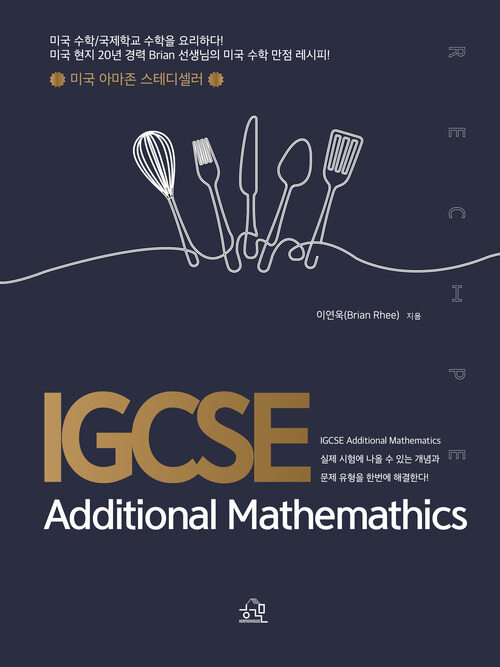
- 평점평점점평가없음
- 저자이연욱 지음
- 출판사헤르몬하우스
- 출판일2023-07-04
- 등록일2024-11-11
- 파일포맷pdf
- 파일크기8 M
- 지원기기
PCPHONETABLET 프로그램 수동설치전자책 프로그램 수동설치 안내
아이폰, 아이패드, 안드로이드, 태블릿, PC
책소개
이 책은 방대한 IGCSE Additional Mathematics의 토픽들을 15개의 토픽으로 세분화하였습니다. IGCSE Additional Mathematics 시험에 출제될 수 있는 모든 개념과 실전시험에 나오는 모든 문 제유형들을 포함하여 실전시험에 대한 적응력을 높일 수 있도록 구성했습니다. 이 책을 통해서 중학교 과정의 탄탄한 수학 실력을 쌓을 수 있는 것은 물론이고 향후 공부하게 되는 IB Math나 A-Level 등의 이후 고등학교 수학에 있어서의 든든한 기초가 될 것입니다.
이 책은 미국 및 한국의 학원교재와 1:1 개인지도 교재로 기획되어 미국에서 먼저 출판하였으며, 미국 아마존 닷컴에서는 스테디셀러로 학생들의 인기를 얻고 있습니다. 동시에 No.1 유학전문 인터넷 강의 사이트인 마스터프렙(www.masterprep.net)에서 IGCSE Additional Mathematics의 교재로 사용되고 있으며 학생들의 좋은 반응으로 수학 교육자의 한 사람으로서 보람을 느끼고 있습니다. 책의 기획 의도상 교재에는 Answer keys만 포함되어 있고 상세한 풀이는 포함되지 않았습니다. 자세한 풀이를 원하는 학생들은 지도하시는 선생님께 도움을 요청하시거나 마스터프렙의 인터넷 강의를 듣는 것을 추천합니다.
저자소개
미국 버지니아의 No.1 수학전문 학원인 솔로몬 학원(Solomon Academy)의 대표이자 소위 말하는 1타 수학 강사이다. 버지니아에 위치한 명문 토마스 제퍼슨 과학고(Thomas Jefferson High School for Science & Technology) 및 버지니아 주의 유명한 사립, 공립학교의 수 많은 학생을 지도하면서 명성을 쌓았고 좋은 결과로 입소문이 나 있다. 그의 수많은 제자들이 Harvard, Yale, Princeton, MIT, Columbia, Stanford 와 같은 아이비리그 및 여러 명문 대학교에 입학하였을 뿐만 아니라, 중학교 수학경시대회인 MathCounts에서는 버지니아 주 대표 5명 중에 3명이 바로 선생님의 제자라는 점과, 지도한 다수의 학생들이 미국 고 교 수학경시대회인 AMC, AIME를 거쳐 USAMO에 입상한 사실들은 선생님의 지도방식과 능력을 입증하고 있다. 현재 미국과 한국을 오가면서 강의하고 있으며, 한국에서는 SAT 전문 학원에서의 강의와 더불어 No.1 유학전문 인터넷 강의 사이트인 마스 터프렙(www.masterprep.net)에서 SAT 2 Math Level 2 강의를 시작으로 AP Calculus와 그 외의 다른 수학 과목을 영어 버전과 한국어 버전으로 강의하고 있다.아마존닷컴(www.amazon.com)에서 미국수학전문 교재의 스테디셀 러 저자이기도 한 선생님은 SAT 2 Math Level 2, SAT 1 Math, SHSAT/ TJHSST Math workbook, IAAT와 AP Calculus AB & BC 등 다수의 책을 출판하였고, 지금도 여러 수학책을 집필 중이며 한국에서도 지속적으로 선생님의 책이 시리즈로 소개될 예정이다.
목차
CHAPTER 1 Functions 9
1.1 Definition of a function 9
1.2 Composition functions 13
1.3 Modulus or absolute value functions 14
1.4 Inverse functions 16
1.5 Transformations 19
CHAPTER 2 Quadratics 29
2.1 Quadratic functions 29
2.2 Maximum and minimum value by completing the square 31
2.3 Solving quadratic equations 32
2.4 Solving quadratic inequalities 34
2.5 Discriminant of a quadratic equation 35
CHAPTER 3 Indices and surds 43
3.1 Simplifying expressions involving indices 43
3.2 Solving equations involving indices 45
3.3 Simplifying expressions involving surds 47
3.4 Rationalizing the denominator 48
3.5 Solving equations involving surds 49
CHAPTER 4 Factors of polynomials 57
4.1 Operations with polynomials 57
4.2 Finding zeros of a polynomial function 59
4.3 The remainder theorem 60
4.4 The factor theorem 62
4.5 Rational zeros theorem 64
4.6 Graphing cubic functions 67
4.7 Solving cubic inequalities graphically 68
CHAPTER 5 Logarithmic and exponential functions 77
5.1 Logarithms 77
5.2 Properties of logarithms 79
5.3 Solving exponential and logarithmic Equations 82
5.4 Graphs of logarithmic and exponential functions 84
5.5 Graphs of y = kenx+ a and y = k ln (ax+b) 85
CHAPTER 6 Straight-line graphs 95
6.1 Coordinate geometry 95
6.2 Finding areas of polygons using shoelace method 98
6.3 Linear law 100
CHAPTER 7 Coordinate geometry of circles 109
7.1 The standard equation of a circle 109
7.2 Intersection of a circle and a straight line 111
7.3 The equation of a tangent line to a circle 113
7.4 Intersection of two circles 114
CHAPTER 8 Trigonometry 119
8.1 Circular measure 119
8.2 Finding the exact value of the trigonometric functions 123
8.3 Graphs of trigonometric functions 128
8.4 Solving trigonometric equations 134
8.5 Proving trigonometric identities 136
8.6 Area of non-right angled triangles 138
8.7 Solving triangles using the law of sines and cosines 139
CHAPTER 9 The binomial theorem 155
9.1 The Fundamental Counting Principle 155
9.2 Permutation and combination 157
9.3 The binomial theorem 159
CHAPTER 10 Sequence and series 169
10.1 Sequence 169
10.2 Series 172
CHAPTER 11 Vectors 181
11.1 Vector notation 181
11.2 Algebraic operations on vectors 183
11.3 Vector geometry 184
11.4 Constant velocity problems 191
CHAPTER 12 Derivative functions 199
12.1 Instantaneous rate of change 199
12.2 Finding the derivative functions 202
12.3 Tangent and normal lines 204
CHAPTER 13 Differentiation rules 211
13.1 The product and quotient rules 211
13.2 The chain rule 214
13.3 The second derivative 217
CHAPTER 14 Applications of differentiation 225
14.1 Small increments and approximations 225
14.2 Related rates 228
14.3 Understanding a curve from the first and second derivatives 231
14.4 Local maximum and local minimum 233
14.5 Practical maximum and minimum problems 236
CHAPTER 15 Integration 245
15.1 Indefinite integrals 245
15.2 The U-Substitution rule 250
15.3 Definite integrals 254
15.4 Area between two curves 257
15.5 Kinematics 260













